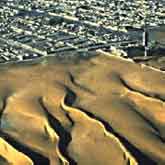A River of Sand
 Next time you're at the beach or in the desert, climb a sand dune in bare feet on a windy day. Stand still in various places on the gently sloping windward side. Watch how wind-driven sand grains appear to jump an inch or two above the dune, stinging your ankles and making the dune's surface appear to be in constant motion ever upward toward the crest. At the dune's crest, kneel to examine closely what's happening. Watch how airborne sand grains fall and cascade down the steep lee slope in tiny avalanches. Start hiking down the lee side; notice how suddenly still the air feels, especially just past the dune's crest. You've just observed how dunes grow.
Next time you're at the beach or in the desert, climb a sand dune in bare feet on a windy day. Stand still in various places on the gently sloping windward side. Watch how wind-driven sand grains appear to jump an inch or two above the dune, stinging your ankles and making the dune's surface appear to be in constant motion ever upward toward the crest. At the dune's crest, kneel to examine closely what's happening. Watch how airborne sand grains fall and cascade down the steep lee slope in tiny avalanches. Start hiking down the lee side; notice how suddenly still the air feels, especially just past the dune's crest. You've just observed how dunes grow.
More importantly, you've also just seen how dunes can migrate--a grave concern in nations where the relentless advance of desert dunes is a serious threat to habitation and agriculture. In arid northern China, for example, dunes are advancing on some villages at a rate of 20 meters per year. Parts of Africa and the Middle East are likewise threatened. How do you stop a moving sand dune? In some places people simply drench the sand with oil--it's effective, but not very good for the environment. Sand fences, like snow fences, can also help, although in many cases their design is little more than guesswork. Engineers are disadvantaged because there's no complete physical theory for the behaviour of these dunes.
Physicists have long had neat mathematical equations that fully describe the behavior of solids like bricks, liquids like water, and gases like air. But granular materials like sand dunes don't quite fit in any of those categories. Grainy substances are so hard to figure out because they're so complex. Even a supercomputer can't keep track of all the interactions.
About the Author
NASA Marshall Space Flight Center
 The George C. Marshall Space Flight Center, located in Huntsville, Alabama, is the U.S. government's civilian rocketry and spacecraft propulsion research center. As the largest NASA center, MSFC's first mission was developing the Saturn launch vehicles for the Apollo program.
The George C. Marshall Space Flight Center, located in Huntsville, Alabama, is the U.S. government's civilian rocketry and spacecraft propulsion research center. As the largest NASA center, MSFC's first mission was developing the Saturn launch vehicles for the Apollo program.


